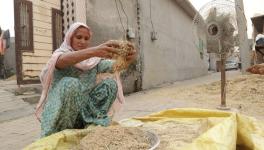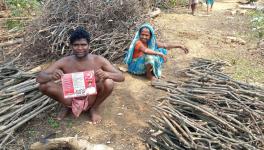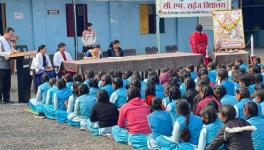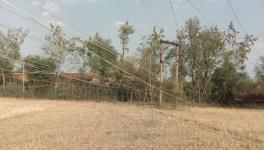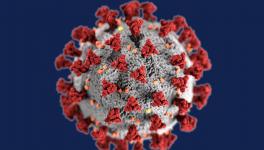COVID-19 in Rural India-XXXVI: Farmers Forced to Sell Paddy Below MSP in Bengal’s East Medinipur
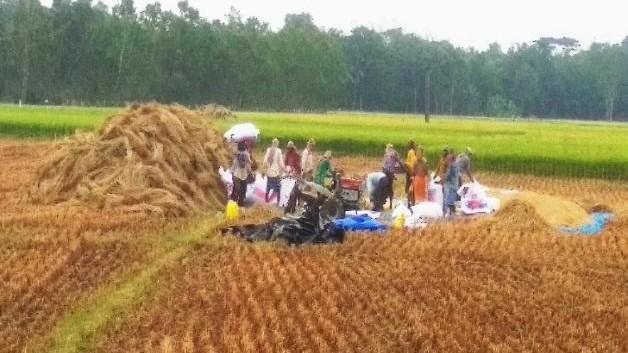
Farm workers harvesting paddy.
This is the 36th report in a series that provides glimpses into the impact of COVID-19-related policies on life in rural India. The series, commissioned by the Society for Social and Economic Research, comprises reports by various scholars who have been conducting village studies in different parts of India. The reports have been prepared on the basis of interviews with key informants in their study villages. This report talks about the difficulties faced by small farmers and prawn cultivators in Kismat Patna village which falls in East Medinipur district of West Bengal. The report also looks at how the lockdown has affected daily wage workers and those involved in dairy business.
Kismat Patna village is part of the Mugberia Gram Panchayat in the East Medinipur district of West Bengal. The Lolat Janka road, which is part of a network of roads and national highways, passes through the southern boundary of the village and connects it to the state capital, Kolkata (133 km away). The nearest railway station is Henria, which is 10 km away.
According to a Gram Panchayat member, the population of Kismat Patna is presently 989 individuals across 237 households. The village is dominated by general or Forward Caste households (184 families), followed by Scheduled Caste households (40 families) and finally Other Backward Caste households (13 families). Most Forward Caste households own some agricultural land. There are 20 landless families in the village from the SC and OBC categories; members of these households work as agricultural labourers, construction workers, in fishing and selling fish, in dairy farming, as vegetable vendors, running grocery shops and food stalls, and in their traditional caste occupations. As on April 16, 2020, about 20 people from the village had migrated to the cities of Mumbai and Bangalore and the state of Kerala to work as construction workers and in the electronics industry.
Agriculture in Kismat Patna and the impact of the lockdown
Agriculture is the primary source of income for most villagers in Kismat Patna. The village has very good irrigation facilities, mainly shallow wells. Many farmers cultivate paddy twice: once as a kharif (locally called aman) crop, meant mainly for household consumption and once as a rabi (locally called boro) crop that is meant for sale. A few farmers also manage to grow a third pre-kharif paddy crop (locally called aus), mainly to obtain seeds for the boro season. The aman crop is usually of the Santoshree or Padoshree variety of rice, while the boro crop is mostly of hybrid rice varieties, such as N Sankar or Super Sankar. The returns from the boro crop are high because of the high productivity of hybrid paddy and market prices that are always above the minimum support price (MSP). According to farmers, the recent boro crop has been good. Small farmers usually do not sell their harvested paddy in the mandi. During the harvest season, traders and commission agents come to the village to purchase paddy from small farmers.
The lockdown has caused a shortage of agricultural workers as many are afraid to leave their homes and villages to go to work. Given the present shortage, the next couple of weeks are likely to see both a rise in the demand for labour and the wage rate. According to the respondents, many farmers anticipate having to rely on family labour to harvest their paddy crops.
Further, the lack of transport during the lockdown has impacted crop sales. Only a few commission agents and traders—far fewer than in the past—have contacted farmers regarding purchasing their harvests. The low demand has already caused a fall in prices. The price received by farmers for paddy in mid-April this year was between Rs 1,030 and 1,080 for a 60 kg bag. Not only is this price below that received in April last year (between Rs 1,200 and Rs 1,300 for a 60 kg bag of the same paddy), it is even lower than the MSP for paddy announced this year. The MSP for paddy in Bengal this year is Rs 1,815 for a quintal, i.e., Rs 1,089 for a 60 kg bag. Although paddy is not a perishable item, poor storage infrastructure could expose the harvested crop to damage by pests. Also, the longer paddy is stored, the more the grain dries up, leading to a fall in weight that could result in lower earnings. This is a concern as most small farmers do not have the necessary infrastructure to store their grain until prices improve. As one respondent remarked, “We can’t wait for a better price, as we need urgent cash after harvest to repay the borrowed money, have to pay for irrigation, fertilisers and wages of labourers.” However, this is not a big concern for economically well-off farmers with large landholdings, as they usually have storage facilities that will allow them to wait a few months to sell their produce at better prices. In addition to this, there was untimely heavy rainfall on April 17 and 18. To prevent damage to the crop, which was ready to be harvested, farmers had to hire additional hands. Given the shortage of labour, wage rates had increased from Rs 400 per day to Rs 450 per day. Small farmers have thus been hit hard by both higher wage costs for harvesting and a lower selling price for paddy.
Impact on Prawn Farmers
East Medinipur district is one of the largest producers of prawns in the state. In Kismat Patna, a few individuals who own land and have access to capital are engaged in prawn cultivation. The supply chain in prawn cultivation involves a large number of people: suppliers of feed, seeds and medicines, technical experts, farmers, labourers and traders. This is also a relatively capital intensive business—most farmers have to borrow money from moneylenders or banks in order to meet their input costs. Generally, two cultures are done in a year, with each culture taking a minimum of three months and up to a hundred days to complete. Farmers usually start preparing the water for shrimp and prawn cultivation in late February and early March for the first culture. This is the peak season for the culture of ‘venami’ prawns, which are in high demand in both the domestic and international markets.
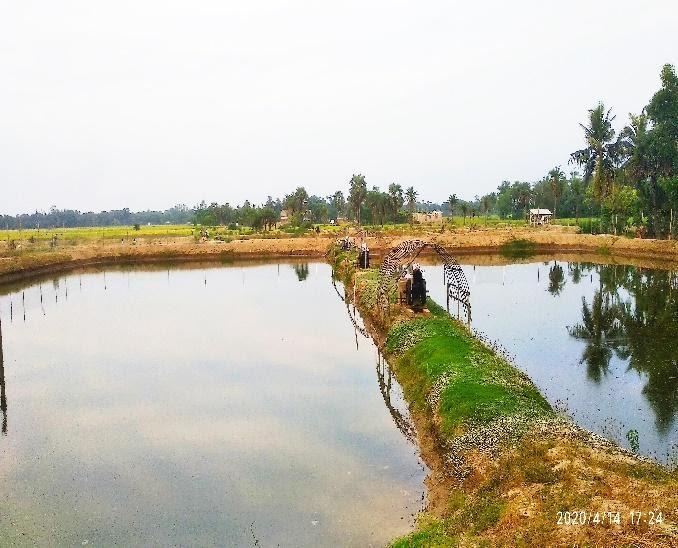
Inactive prawn cultivation areas
The repercussions of the imposition and extension of the nationwide lockdown, as well as the impact of the pandemic on international demand and prices are sources of worry for prawn farmers. The availability of raw materials has already declined; if the lockdown is further extended, this could lead to a shortage of essential materials in the mid-culture period. Suppliers of seeds, feed, medicine and other materials often offer these on credit, with farmers paying them in cash after the harvest or having their dues deducted during procurement (if farmers sell their prawn to the same suppliers). But suppliers have been unwilling to extend credit or even accept part payment during the lockdown. Prawn farmers can still start the first culture in a few weeks’ time, but any further delay would put the second culture in jeopardy, as climatic conditions such as cooler weather (during the second culture) would restrict the growth of prawns and increase the chances of infection. Despite the difficulties posed by the lockdown, some farmers have started their first cultures, but concern over demand and prices has made them decrease the area under prawn cultivation. There are no guidelines issued by the government with regard to prawn cultivation during the lockdown.
Impact on Daily Wage Labourers, Dairy Farmers and Milk Sellers
Materials for construction have been unavailable during the lockdown, which has put daily wage labourers in construction out of work. One such labourer reported that, in the absence of income and financial support from the government, they may not have the means to purchase food. The respondent who is working with the Gram Panchayat said they had not received any information about new employment under the MGNREGS and that there was no work being undertaken under the scheme during the lockdown.
There are 13 OBC families in the village who depend on dairy farming and the allied businesses of sweet-making and milk selling, which are their traditional caste (Goala-Gope) occupations. This includes collecting cow’s milk from neighbouring villages and preparing and selling dahi (curd) in large quantities for weddings, religious ceremonies and so on. According to one such milk collector, “It is the first time in my 26 years of milk business that I have not earned anything for more than 23 days and we are managing somehow on our savings. If this continues, will have to face difficulties in the future.” This respondent is also unsure of his ability to resume business operations when the lockdown is lifted, as dairy farmers in the village have begun supplying milk directly to sweet shops.
There is at present no shortage of basic food items in the market. However, the retail prices of basic goods have increased as shown in the table below.
Table 1: Prices of essential commodities before and during the lockdown in Kismat Patna
According to a member of the Gram Panchayat, villagers have received rations from the state government based on their ration card categories. Some farmers reported having received Rs 1,800 under the central government’s PM-Kisan Samman Nidhi scheme.
ATM and banking facilities are located 2 km from the village. According to the respondents, the villagers have not received any medicines, sanitisers or masks from the government or NGOs.
A key takeaway from the experiences reported by the respondents in Kismat Patna is that rural India seems inadequately prepared to deal with the pandemic. India's agriculture sector is facing an acute crisis, with marginal and small farmers particularly exposed to major challenges. In addition to this, the extension of the nationwide lockdown is going to severely impact winter harvesting and crop sales. Small farmers sold their harvested paddy, which is a superior hybrid variety, at less than the announced MSP. Kismat Patna has no Farmer Producer Organisation (FPO) and there has been no government intervention to procure harvested crops. This will hit the economically weaker small and marginal farmers the hardest. Although the government has issued guidelines with regard to social distancing and the use of masks by those engaged in activities like harvesting, the respondents pointed out the difficulty of actually implementing these in the field. Food security and employment prospects of many in Kismat Patna remain areas of acute concern.
[This report is based on in-person interviews with four farmers: two small farmers (less than two bighas), one large farmer (10 bighas), and one sharecropper. There were also a daily wage labourer, one milkman/milk collector, one individual employed at a fishery feed shop, and one member of the Gram Panchayat among the respondents. The interviews were conducted between April 15 and 20, 2020.]
The author is a PhD scholar at the Department of Humanities and Social Sciences in Indian Institute of Technology, Guwahati.
Get the latest reports & analysis with people's perspective on Protests, movements & deep analytical videos, discussions of the current affairs in your Telegram app. Subscribe to NewsClick's Telegram channel & get Real-Time updates on stories, as they get published on our website.










